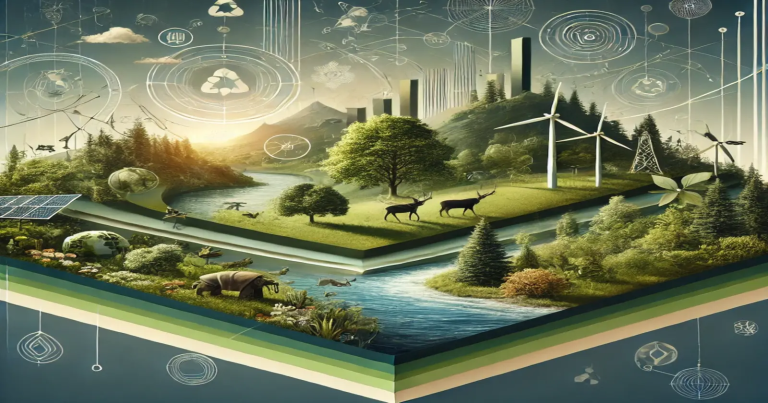The term environment refers to the surroundings in which living organisms, humans and animals, and plants exist. It involves the natural environment, which contains ecosystems, landscapes, air, water, and biodiversity. It also covers the built environment, which includes human-made structures, such as buildings, roads, and cities. The environment encompasses everything that affects an organism’s life from physical influences to chemical, biological, and human factors. It is a great understanding of the environment to understand how it supports life, helps retain ecological balance, and encourages sustainable development.
What is Environment?
The environment comprises both natural and man-made surroundings. It is responsible for the influence of ways of life and relationships with the world. The biotic components include plants, animals, and microorganisms. And, abiotic factors are air, water, soil, and climate. All these provide ample resources that are essential for life to stay intact on Earth like oxygen, water, food, and raw materials.
Key Components of the Environment
- Biotic Components: These are the living elements, such as flora and fauna, that interact with each other within an ecosystem.
- Abiotic Components: These are the non-living physical and chemical factors like sunlight, temperature, water, and minerals. They influence living organisms.
- Natural Environment: The natural world, including forests, oceans, rivers, mountains, and deserts. Also includes, atmospheric conditions like weather and climate.
- Human Environment: The areas impacted by human activities. Like, cities, farms, infrastructure, and industrial areas.
What are the Activities of the Environment?
Environmental activities refer to the natural processes and human inputs in this environment. According to Mike Jones, the activities can be broken down into two different categories:
Natural Activities
- Ecosystem Functions: The environment supports ecosystems where species interact. This includes nutrient cycling, energy flow, and food chains.
- Natural Disasters: Phenomena like earthquakes, floods, volcanic eruptions, and hurricanes, which are a part of Earth’s natural processes.
- Climate Systems: The interaction of atmospheric, oceanic, and land systems in regulating weather patterns and climate.
Human-Induced Activities
Human activities cause environmental stresses. It imposes effects on biodiversity and the proper functioning of ecosystems. Human development, is seen to be in balance with appropriate environmental practices such as environmentally sustainable development.
- Urbanization: The expansion of cities and towns which alters landscapes and ecosystems.
- Industrialization: Human activities such as manufacturing, mining, and agriculture. That use environmental resources, often leading to pollution.
- Deforestation: The large-scale removal of trees for agriculture or urban development. It leads to loss of biodiversity and disruption of ecosystems.
What is Environmental Sustainable Development?
Sustainable development is a means of attaining and satisfying the needs of the present generation without hindering the ability of future generations to meet their own needs. Sustainable development combines the approach to economic development, social welfare, and environmental protection.
Pillars of Sustainable Development
- Economic Sustainability: Promotes the prudent use of resources. It aims for long-term economic growth without depleting natural resources. It is a responsibility to defend the environment and natural wealth.
- Social Sustainability: It guarantees the preservation of human rights, equality and social justice. It means working toward the welfare of the community in this generation and others to come.
- Sustainable environment: Concentrates on the conservation of ecosystems and natural resources. Enabling waste reduction, and addressing environmental degradation.
Examples of Sustainable Practices
Sustainable development is essential in ensuring an equitable balance between human progress and the preservation of Earth’s ecosystems. It acts as a cornerstone for an appropriate setting, social equity, and an economically fit future for generations ahead.
- Renewable Energy: Using wind, solar, and hydropower instead of fossil fuels to reduce carbon emissions.
- Sustainable Agriculture: Implementing eco-friendly farming practices that preserve soil health, water resources, and biodiversity.
- Circular Economy: Minimizing waste by reusing and recycling materials, reducing the strain on natural resources.
What is Environmental Degradation?
Environmental degradation is the deterioration of the natural environment caused by human activity or natural processes that degrade resources and biodiversity, destroying ecosystems; it can be caused by pollution, deforestation, overexploitation of resources, or urban sprawl. Some common causes of environmental degradation:
- Deforestation: The removal of trees either to be sold for lumber or to clear space for agriculture. It contributes to habitat loss and climate change.
- Pollution: The release of harmful substances into the air, water and soil, usually as a result of human activity. It contributes to health problems.
- Overpopulation: Human activities are intensified. More natural resources are utilized, and more waste is generated.
- Climate Change: The warming of the planet is driven by the buildup of heat-trapping greenhouse gases. It causes the rise of sea levels, extreme weather and other environmental shifts.
Implications of Ecological Destruction
- Biodiversity losses: Once ecosystems undergo degradation, they may not be able to support organisms living in them and thus may vanish them from the planet.
- Loss of Quality of Life: Deteriorated condition of the surroundings causes low air and water quality that is harmful for the humans.
- Financial Loss: Impairment of natural resources can lower agricultural production. It also adds to costs of disaster relief.
Preventing environmental degradation is essential for sustaining life on Earth and maintaining the balance of ecosystems that provide vital resources.
What is Environmental Protection?
Environmental protection is the attempt to preserve the natural environment from destructive factors created by man. Such laws also encompass conserved efforts and initiatives. Which keep the health of ecosystems in good condition or to recover it further. Forms of Environmental Protection:
- Conservation of Natural Resources: Sustainable use of water, forests, and minerals to prevent overexploitation.
- Pollution Control: Regulations to limit air, water, and soil pollution. This can be done by waste management systems and emissions controls in industries.
- Wildlife Protection: Laws and initiatives to conserve endangered species and protect habitats from human encroachment.
- Renewable Energy Adoption: Encouraging the shift from fossil fuels to renewable energy sources to reduce greenhouse gas emissions.
Key Environmental Protection Initiatives
Therefore, the government, organizations, and individuals should collectively work to protect the environment. This will be an essential step for maintaining ecosystems, utilizing available natural resources, and avoiding further degradation of the environment.
- The Kyoto Protocol and Paris Agreement: International treaties focused on reducing global carbon emissions and mitigating climate change.
- Conservation Movements: Organizations such as the World Wildlife Fund (WWF) and Greenpeace promote environmental awareness and conservation practices.
Environment FAQs
What is an environment?
The word environment has often been described as the sum of all natural and human-made features. It characterizes the living surroundings where air and water co-exist with ecosystems and man-made structures impacting life on Earth.
What is environmental sustainable development?
Environmental sustainable development is the process of meeting the needs of the present generation without compromising for future generations the ability to meet their own needs. But, within the limits of the economic, social, and environmental considerations.
What are some examples of environmental degradation?
Examples include habitat degradation, such as deforestation; air and water pollution; loss of biodiversity. And climate change that harms ecosystems and reduces resource availability.
What is environmental protection?
Environmental protection is conserving the ecosystems by minimizing pollution, and reducing degradation of the environment. This is done by way of regulations and sustainable practices.
What are some ways of reducing environmental degradation?
By embracing renewable energy, conserving resources, reducing pollution, and promoting sustainable development.


